Association Between Gout Flare and Subsequent Cardiovascular Events Among Patients With Gout
- PMID: 35916846
- PMCID: PMC9346550
- DOI: 10.1001/jama.2022.11390
Association Between Gout Flare and Subsequent Cardiovascular Events Among Patients With Gout
Abstract
Importance: Gout is associated with cardiovascular diseases. The temporal association between gout flares and cardiovascular events has not been investigated.
Objective: To investigate whether there is a transient increase in risk of cardiovascular events after a recent gout flare.
Design, setting, and participants: A retrospective observational study was conducted using electronic health records from the Clinical Practice Research Datalink in England between January 1, 1997, and December 31, 2020. A multivariable nested case-control study was performed among 62 574 patients with gout, and a self-controlled case series, adjusted for season and age, was performed among 1421 patients with gout flare and cardiovascular event.
Exposures: Gout flares were ascertained using hospitalization, primary care outpatient, and prescription records.
Main outcomes and measures: The primary outcome was a cardiovascular event, defined as an acute myocardial infarction or stroke. Association with recent prior gout flares was measured using adjusted odds ratios (ORs) with 95% CIs in a nested case-control study and adjusted incidence rate ratios (IRRs) with 95% CIs in a self-controlled case series.
Results: Among patients with a new diagnosis of gout (mean age, 76.5 years; 69.3% men, 30.7% women), 10 475 patients with subsequent cardiovascular events were matched with 52 099 patients without cardiovascular events. Patients with cardiovascular events, compared with those who did not have cardiovascular events, had significantly higher odds of gout flare within the prior 0 to 60 days (204/10 475 [2.0%] vs 743/52 099 [1.4%]; adjusted OR, 1.93 [95% CI, 1.57-2.38]) and within the prior 61 to 120 days (170/10 475 [1.6%] vs 628/52 099 [1.2%]; adjusted OR, 1.57 [95% CI, 1.26-1.96]). There was no significant difference in the odds of gout flare within the prior 121 to 180 days (148/10 475 [1.4%] vs 662/52 099 [1.3%]; adjusted OR, 1.06 [95% CI, 0.84-1.34]). In the self-controlled case series (N = 1421), cardiovascular event rates per 1000 person-days were 2.49 (95% CI, 2.16-2.82) within days 0 to 60; 2.16 (95% CI, 1.85-2.47) within days 61 to 120; and 1.70 (95% CI, 1.42-1.98) within days 121 to 180 after a gout flare, compared with cardiovascular event rates of 1.32 (95% CI, 1.23-1.41) per 1000 person-days within the 150 days before or the 181 to 540 days after the gout flare. Compared with 150 days before or the 181 to 540 days after a gout flare, incidence rate differences for cardiovascular events were 1.17 (95% CI, 0.83-1.52) per 1000 person-days, and adjusted IRRs were 1.89 (95% CI, 1.54-2.30) within days 0 to 60; 0.84 (95% CI, 0.52-1.17) per 1000 person-days and 1.64 (95% CI, 1.45-1.86) within days 61 to 120; and 0.38 (95% CI, 0.09-0.67) per 1000 person-days and 1.29 (95% CI, 1.02-1.64) within days 121 to 180 after a gout flare.
Conclusions and relevance: Among individuals with gout, those who experienced a cardiovascular event, compared with those who did not experience such an event, had significantly higher odds of a recent gout flare in the preceding days. These findings suggest gout flares are associated with a transient increase in cardiovascular events following the flare.
Conflict of interest statement
Figures




Comment in
-
Cardiovascular Events and Gout Flares.JAMA. 2022 Aug 2;328(5):425-426. doi: 10.1001/jama.2022.9165. JAMA. 2022. PMID: 35916865 No abstract available.
-
Gout flares can precede cardiovascular events.Nat Rev Cardiol. 2022 Oct;19(10):642. doi: 10.1038/s41569-022-00766-x. Nat Rev Cardiol. 2022. PMID: 35978010 No abstract available.
-
Beyond joint pain, could each gout flare lead to heart attack?Nat Rev Rheumatol. 2022 Nov;18(11):619-620. doi: 10.1038/s41584-022-00844-x. Nat Rev Rheumatol. 2022. PMID: 36131085 No abstract available.
-
Gout Flare and Cardiovascular Events.JAMA. 2023 Jan 3;329(1):96. doi: 10.1001/jama.2022.20111. JAMA. 2023. PMID: 36594952 No abstract available.
References
-
- Roth GA, Mensah GA, Johnson CO, et al. ; GBD-NHLBI-JACC Global Burden of Cardiovascular Diseases Writing Group . Global Burden of Cardiovascular Diseases and Risk Factors, 1990-2019: update from the GBD 2019 study. J Am Coll Cardiol. 2020;76(25):2982-3021. doi: 10.1016/j.jacc.2020.11.010 - DOI - PMC - PubMed
-
- Willerson JT, Ridker PM. Inflammation as a cardiovascular risk factor. Circulation. 2004;109(21)(suppl 1):II2-II10. - PubMed
Publication types
MeSH terms
LinkOut - more resources
Full Text Sources
Other Literature Sources
Medical

